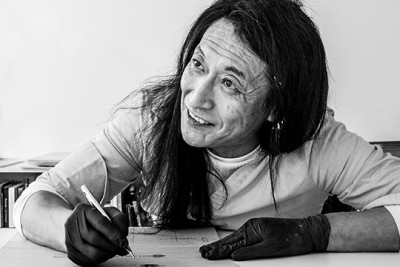YUTAKA SONE OBSIDIAN
14.12.2023 – 18.02.2024
‘Somebody broke the glass’
— Yutaka Sone
‘Somebody broke the glass’ is a four-word poem by the Japanese artist Yutaka Sone. The poem refers to the use of obsidian, a naturally occurring volcanic glass formed by the rapid cooling of molten lava. Under certain circumstances, when a volcano erupts violently and drops of lava end up in the sea or other cold environments, they form almost perfectly round volumes of obsidian. This is where the potential time span in the search for meaning starts for our poet. Archaeologists know that pieces of obsidian have been used as tools of all kinds since prehistoric times, due to their sharpness and weight. It is believed that the forces of nature initially broke large chunks of obsidian into useable shards, which were then picked up and used by humans, whether for hunting or survival.
What Sone tries to imagine is the exact moment when ‘someone’ projected his desire to make a means to an end, a specific object, and purposefully broke a piece of obsidian into a specific shape (a technique known as knapping), using his own personal ‘stroke’. When shaping objects by knapping, the strokes of the ‘carver’ can be compared to modern handwriting – unique to the creator and done intentionally. Thousands of these man-made pieces of obsidian have been found around the world. We know this from the scientists. The shards bear evidence (strokes) of the perhaps hundreds of millions of anonymous ‘makers’, from prehistory to the present.
Several years ago, Sone’s interest in the history of how cultures across the world are shaped by the ‘stroke’of millions of anonymous inhabitants (think of rattan webbers in Mexico, or stone workers in China’s Fujian region)1 led him to become fascinated with obsidian. In 2017, the artist tried to teach himself the inner logic of the stone by making numerous drawings until he could draw a perfect, however none excising piece of obsidian. He then tried to sculpt some enlarged pieces of obsidian in Chinese grey stone, but without success. During the sculpting process, Sone started to understand that by re-carving the shape of obsidian, he was also re-creating the ‘stroke of anonymous’, but equally replacing these anonymous strokes by his own carving.2 This was not, however, the artist’s intent.
What Sone was looking for is to make this ‘anonymous stroke’ visible, by adding to an already pre-existing history. As an individual artist, this is almost impossible; the artist would have to create in anonymity, but then his desire to make his concept visible would remain anonymous too. So, Sone is currently working under the conceptual framework of ‘anonymous+’ (anonymous + his own ‘stroke’), in an attempt to create a new series of sculptures that refer to the cradle of civilisation in the first place.3 The moment where humans first used their imagination to create the tools of society. Somewhere between nature forming the first obsidian and humans producing society via imagination is exactly the point Sone wants us to understand.
We don’t know much about who or when the first obsidian was carved by a human. But one thing we can be sure of: ‘Somebody broke the glass’.
1) Also think of Sone’s marble city-islands as depictions of the political/social model of ‘democracy’. The cities’ sociological structure and hence their ‘culture’ can be understood as being ‘made by anonymous’.
Tommy Simoens
